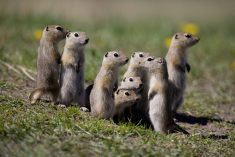We have a very short growing season here at Busby, Alta. We start to green up at the end of April or in early May and are usually hit with a killing frost by mid-September. We have about five months to grow 12 months’ worth of feed.
Now, some might take that as a disadvantage. I see it as an advantage. Because we are so far north, our days are much longer in the summer. We can collect a lot more sun per day and therefore produce a lot of feed in a short amount of time. The killing frost is a tool to help maintain a high-quality feed into the winter. This means our grazing season can be a lot longer than our growing season. If we can manage to keep our forage in a vegetative state when the killing frost hits, our feed value gets locked in. If the snow comes early enough to cover it, the feed value will stay high even longer. The killing frost is my haybine and the snow is my hay shed. I have had bright green forage under the snow in January as well over 13 per cent protein.
Read Also

The Canadian Cattle Association’s international advocacy efforts
Global ag policies affect Canadian food policy, so the Canadian Cattle Association participates in international and domestic forums
Keeping pastures in a vegetative state in the late summer is easier said than done. This requires managing pastures in an advanced grazing system of some kind, planning rotations around multiple paddocks to optimize growth and allow recovery.
To recap, to use an advanced grazing system you will need to plan for a short enough graze period and a long enough rest period to prevent overgrazing. It will need to provide both physical and biological animal impact to stimulate soil. It will also need to increase stock density enough to get good plant utilization and adequate manure distribution. Last, a good advanced grazing system needs to build the soil armour to protect the soil and heal the water cycle. Think GRASS for short.
Back to our issue at hand — managing the forage for fall grazing. The key to fall grazing is managing the spring flush. How do we get around all our paddocks and knock down that fast-growing spring flush so that it doesn’t get away on us and mature? It is tough. You can be the best grazier and this is still only going to get you so far. We need some other tools to help. We need to plan.
Some producers will hay or silage part of their forage land on the first rotation and then leave the second rotation for the livestock. This not only knocks down this spring flush but also gets you some added forage for winter feeding. From the other perspective, having grazing livestock on your hayland is a big step forward in sustainability. Biological animal impact is important to keep hayland healthy and helps recycle nutrients instead of exporting them. This is a great tool in extending the grazing season.
My favourite tool is a disposable herd. I do not own a tractor or any harvesting equipment so my “solar-powered, self-propelled harvesters” are key to my operation. This disposable herd is a second herd that I use to manage the spring flush. Once the spring flush is over, that herd can be removed from the pastures which allow more acres for the primary herd to graze for the rest of the season.
Let me describe a possible scenario. We have a land base that can handle 200 pairs for the summer under an advanced grazing system. Let’s split the pasture into two grazing cells and plan to graze a primary herd of 100 pairs on half of it. We use a disposable herd of 200 yearlings to graze the other half (200 pairs would be approximately the same stocking rate as 100 pairs plus 200 small yearlings). We could graze both herds separately during the spring flush and then remove the disposable herd in, maybe, July. We had a full stocking rate for the spring flush and then allowed the primary herd of cow-calf pairs to use the full pasture for the remainder of the season. This can potentially double the number of grazing acres that the primary herd can graze in the fall and winter.
There are multiple ways of acquiring a disposable herd. This could be a custom grazing herd you bring in from another producer. It is important to make sure the customer is aware that this is a disposable herd and is willing to take the animals home early. You could also keep your own calves over winter and use them as a disposable herd for the next spring and summer. Your marketing plans will need to be for selling midsummer or maybe have another plan for them to graze or be fed in another location when the spring flush is over. Of course, economics between profit centres will be your main deciding factor in each situation.
I have also made a deal with a next-door neighbour in the past to use his herd as my disposable herd. In this example, he was a continuous grazier and he usually turned out his herd in April. I had three quarters of land for my herd. I gave him a discounted custom-grazing rate and I took his herd for the month of June to graze one of my quarters. By June 1, his pastures did not look very good. I would take his herd on June 1 and manage them in a rotation on one of my quarters for the month. My herd grazed the other two quarters. This was a win-win situation. His pasture was able to rest for the entire month of June and he gained some inexpensive grass with no trucking required. By July 1, his pasture looked much better with 30 days of rest. My win was being able to sell some of that spring growth and having a higher overall stocking rate on all three quarters for the spring flush. For the rest of the season, my herd was able to graze the second grazing of all three quarters. We actually managed to get a third rotation out of about half of the paddocks.
These are just a few examples of planning to extend the growing season into a much longer grazing season. I’m sure there are many more ways of extending your grazing season. I know every environment is different. What is your plan for managing this year’s spring flush? Can you plan to include a disposable herd to extend your fall grazing?

















